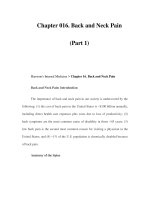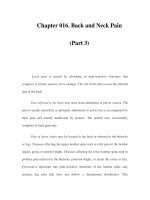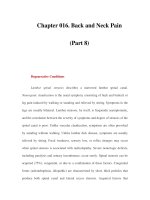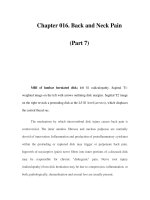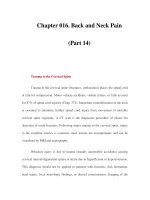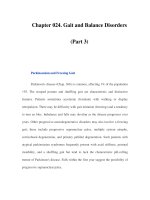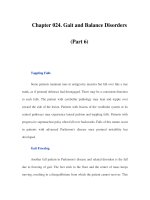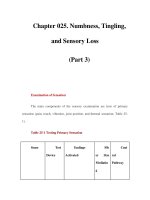Chapter 033. Dyspnea and Pulmonary Edema (Part 3) ppsx
Bạn đang xem bản rút gọn của tài liệu. Xem và tải ngay bản đầy đủ của tài liệu tại đây (22.93 KB, 5 trang )
Chapter 033. Dyspnea and
Pulmonary Edema
(Part 3)
Differential Diagnosis
Dyspnea is the consequence of deviations from normal function in the
cardiopulmonary systems. Alterations in the respiratory system can be considered
in the context of the controller (stimulation of breathing); the ventilatory pump
(the bones and muscles that form the chest wall, the airways, and the pleura); and
the gas exchanger (the alveoli, pulmonary vasculature, and surrounding lung
parenchyma). Similarly, alterations in the cardiovascular system can be grouped
into three categories: conditions associated with high, normal, and low cardiac
output (Fig. 33-2).
Figure 33-2
Respiratory System Dyspnea
Controller
Acute hypoxemia and hypercapnia are associated with increased activity in
the controller. Stimulation of pulmonary receptors, as occurs in acute
bronchospasm, interstitial edema, and pulmonary embolism, also leads to
hyperventilation and air hunger, as well as a sense of chest tightness in the case of
asthma. High altitude, high progesterone states such as pregnancy, and drugs such
as aspirin stimulate the controller and can cause dyspnea even when the
respiratory system is normal.
Ventilatory Pump
Disorders of the airways (e.g., asthma, emphysema, chronic bronchitis,
bronchiectasis) lead to increased airway resistance and work of breathing.
Hyperinflation further increases the work of breathing and can produce a sense of
an inability to get a deep breath. Conditions that stiffen the chest wall, such as
kyphoscoliosis, or that weaken ventilatory muscles, such as myasthenia gravis or
the Guillain-Barré syndrome, are also associated with an increased effort to
breathe. Large pleural effusions may contribute to dyspnea, both by increasing the
work of breathing and by stimulating pulmonary receptors if there is associated
atelectasis.
Gas Exchanger
Pneumonia, pulmonary edema, and aspiration all interfere with gas
exchange. Pulmonary vascular and interstitial lung disease and pulmonary
vascular congestion may produce dyspnea by direct stimulation of pulmonary
receptors. In these cases, relief of hypoxemia typically has only a small impact on
the intensity of dyspnea.
Cardiovascular System Dyspnea
High Cardiac Output
Mild to moderate anemia is associated with breathing discomfort during
exercise. Left-to-right intracardiac shunts may lead to high cardiac output and
dyspnea, although in their later stages these conditions may be complicated by the
development of pulmonary hypertension, which contributes to dyspnea. The
breathlessness associated with obesity is probably due to multiple mechanisms,
including high cardiac output and impaired ventilatory pump function.
Normal Cardiac Output
Cardiovascular deconditioning is characterized by early development of
anaerobic metabolism and stimulation of chemoreceptors and metaboreceptors.
Diastolic dysfunction—due to hypertension, aortic stenosis, or hypertrophic
cardiomyopathy—is an increasingly frequent recognized cause of exercise-
induced breathlessness. Pericardial disease, e.g., constrictive pericarditis, is a
relatively rare cause of chronic dyspnea.
Low Cardiac Output
Diseases of the myocardium resulting from coronary artery disease and
nonischemic cardiomyopathies result in a greater left ventricular end-diastolic
volume and an elevation of the left ventricular end-diastolic as well as pulmonary
capillary pressures. Pulmonary receptors are stimulated by the elevated vascular
pressures and resultant interstitial edema, causing dyspnea. [newpage]


